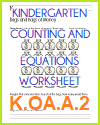| Kindergarten Math: Operations & Algebraic Thinking |
|---|
| www.studenthandouts.com ↣ Kindergarten ↣ Kindergarten Math ↣ Operations & Algebraic Thinking |
| CCSS.MATH.CONTENT.K.OA.A.1: Represent addition and subtraction with objects, fingers, mental images, drawings, sounds (e.g., claps), acting out situations, verbal explanations, expressions, or equations. |
| CCSS.MATH.CONTENT.K.OA.A.2: Solve addition and subtraction word problems, and add and subtract within 10, e.g., by using objects or drawings to represent the problem. |
 | ||||||||||
| Bags of Money Math Worksheet |
| CCSS.MATH.CONTENT.K.OA.A.3: Decompose numbers less than or equal to 10 into pairs in more than one way, e.g., by using objects or drawings, and record each decomposition by a drawing or equation (e.g., 5 = 2 + 3 and 5 = 4 + 1). |
| CCSS.MATH.CONTENT.K.OA.A.4: For any number from 1 to 9, find the number that makes 10 when added to the given number, e.g., by using objects or drawings, and record the answer with a drawing or equation. |
| CCSS.MATH.CONTENT.K.OA.A.5: Fluently add and subtract within 5. |
 | ||||||||||
| 50 States Math Worksheet |
|
Operations and algebraic thinking in kindergarten math introduce children to the basics of arithmetic and logical reasoning.
Students begin to understand addition and subtraction through hands-on activities and visual aids, learning to solve simple problems and recognize relationships between numbers. They explore concepts of equality and inequality, develop strategies for counting, and identify patterns. These early experiences with operations and algebraic thinking build a strong foundation for future mathematical learning, helping children to develop critical thinking skills, foster a sense of numerical fluency, and cultivate a love for problem-solving. |
| www.studenthandouts.com ↣ Kindergarten ↣ Kindergarten Math ↣ Operations & Algebraic Thinking |








